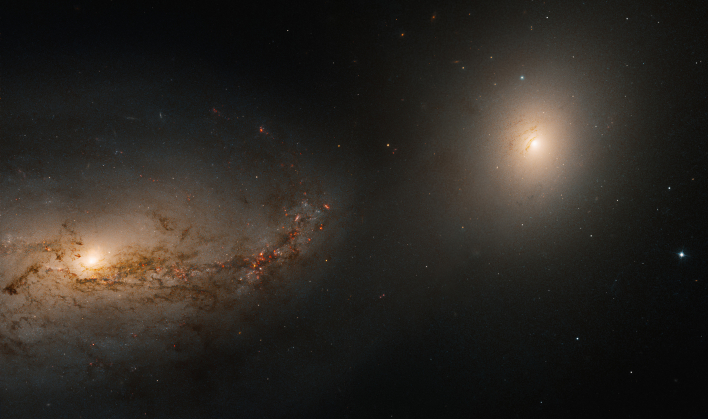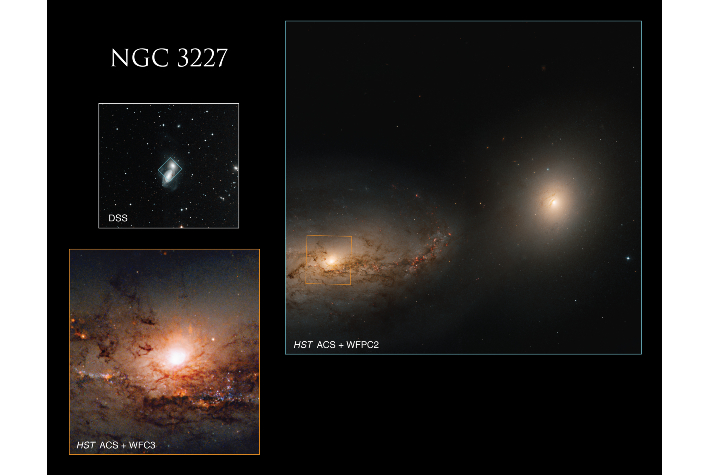Stunning Hubble Image Captures Two Galaxies Dancing With A Cannibalized Cosmic Cadaver
NASA's Hubble Space Telescope captured a tempestuous gravitational dance between two companion galaxies. NGC 3226 and NGC 3227, together known as Arp 94, are located somewhere between 50 and 60 million light-years away from Earth in the constellation Leo.
Hubble continues to send back stunning images ahead of the James Webb Space Telescope (JWST) becoming fully operational in just under two weeks. A recent photo from Hubble posted by the space agency on its website focuses on a Seyfert galaxy, NGC 3227, and an elliptical galaxy, NGC 3226. The two galaxies are "part of a program to measure black hole masses by observing the dynamics of gas at the centers of bright cluster galaxies," according to NASA's blog.
The program aims to understand why local universes fall into two major categories, younger star-forming spirals (like our own Milky Way), and older elliptical galaxies where star making no longer occurs. NGC 3226 is viewed as being in a transitional middle ground, which makes it a very good target for the study.
"We have explored the fantastic potential of the big data archives from NASA's Hubble, Spitzer and ESA's Herschel observatory to pull together a picture of an elliptical galaxy (NGC 3226) that has undergone huge changes in its recent past due to violent collisions with its neighbors," Philip Appleton, project scientist for the NASA Herschel Science Center at the California Institute of Technology in Pasadena, stated in 2014. "These collisions are modifying not only its structure and color, but also the condition of the gas that resides in it, making it hard, at the moment, for the galaxy to form many stars."
Filaments appear to run out from NGC 3226 and its companion galaxy, NGC 3227. The fact that the streamers of material exist, seem to point to the existence of a third galaxy that was cannibalized by NGC 3226 at some point, scattering pieces of the mutilated galaxy all over the area.
Typically adding material to galaxies in this manner will rejuvenate them, instigating a new round of star birth. However, data from the program indicates that NGC 3226 has a very low rate of star formation. The theory is that the material falling into the elliptical galaxy is simply heating up as it collides with other galactic gas and dust, essentially suppressing star formation instead of fueling it.
"We are discovering that gas does not simply funnel down into the center of a galaxy and feed the supermassive black hole known to be lurking there," remarked Appleton. "Rather, it gets hung up in a warm disk, shutting down star formation and probably frustrating the black hole's growth by being too turbulent at this point and time."
Once JWST is fully operational, it will surely target these two galaxies to try and further the understanding of the evolution of galaxies. Until then, we will simply continue to enjoy the incredible imagery that is still being sent back from Hubble.
Top Image Credit: NASA
Hubble continues to send back stunning images ahead of the James Webb Space Telescope (JWST) becoming fully operational in just under two weeks. A recent photo from Hubble posted by the space agency on its website focuses on a Seyfert galaxy, NGC 3227, and an elliptical galaxy, NGC 3226. The two galaxies are "part of a program to measure black hole masses by observing the dynamics of gas at the centers of bright cluster galaxies," according to NASA's blog.
The program aims to understand why local universes fall into two major categories, younger star-forming spirals (like our own Milky Way), and older elliptical galaxies where star making no longer occurs. NGC 3226 is viewed as being in a transitional middle ground, which makes it a very good target for the study.
"We have explored the fantastic potential of the big data archives from NASA's Hubble, Spitzer and ESA's Herschel observatory to pull together a picture of an elliptical galaxy (NGC 3226) that has undergone huge changes in its recent past due to violent collisions with its neighbors," Philip Appleton, project scientist for the NASA Herschel Science Center at the California Institute of Technology in Pasadena, stated in 2014. "These collisions are modifying not only its structure and color, but also the condition of the gas that resides in it, making it hard, at the moment, for the galaxy to form many stars."
Filaments appear to run out from NGC 3226 and its companion galaxy, NGC 3227. The fact that the streamers of material exist, seem to point to the existence of a third galaxy that was cannibalized by NGC 3226 at some point, scattering pieces of the mutilated galaxy all over the area.
Typically adding material to galaxies in this manner will rejuvenate them, instigating a new round of star birth. However, data from the program indicates that NGC 3226 has a very low rate of star formation. The theory is that the material falling into the elliptical galaxy is simply heating up as it collides with other galactic gas and dust, essentially suppressing star formation instead of fueling it.
"We are discovering that gas does not simply funnel down into the center of a galaxy and feed the supermassive black hole known to be lurking there," remarked Appleton. "Rather, it gets hung up in a warm disk, shutting down star formation and probably frustrating the black hole's growth by being too turbulent at this point and time."
Once JWST is fully operational, it will surely target these two galaxies to try and further the understanding of the evolution of galaxies. Until then, we will simply continue to enjoy the incredible imagery that is still being sent back from Hubble.
Top Image Credit: NASA



